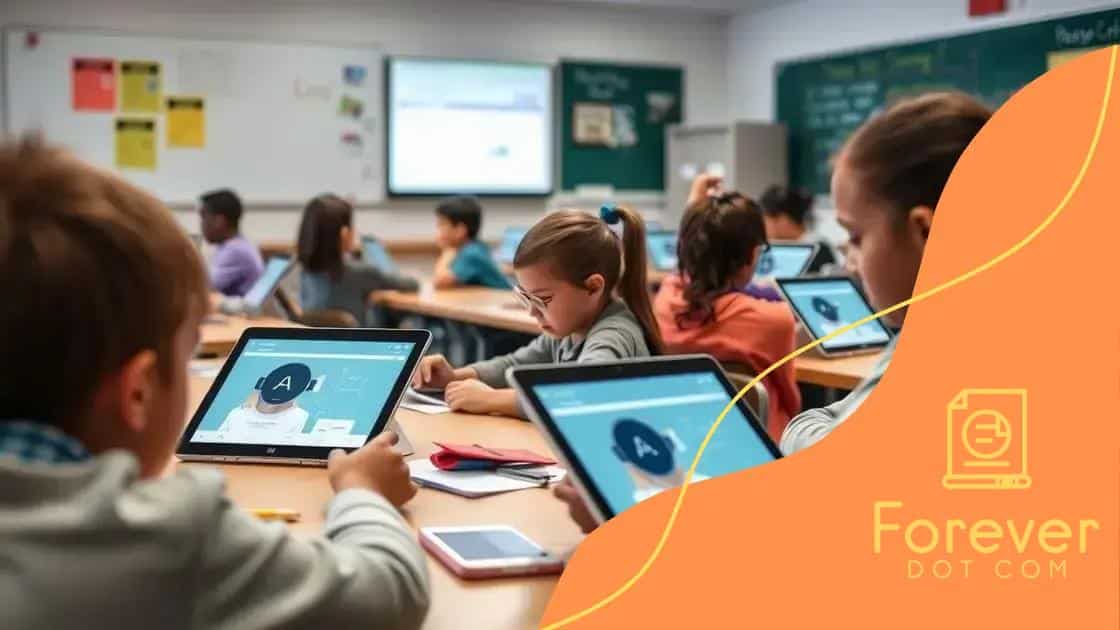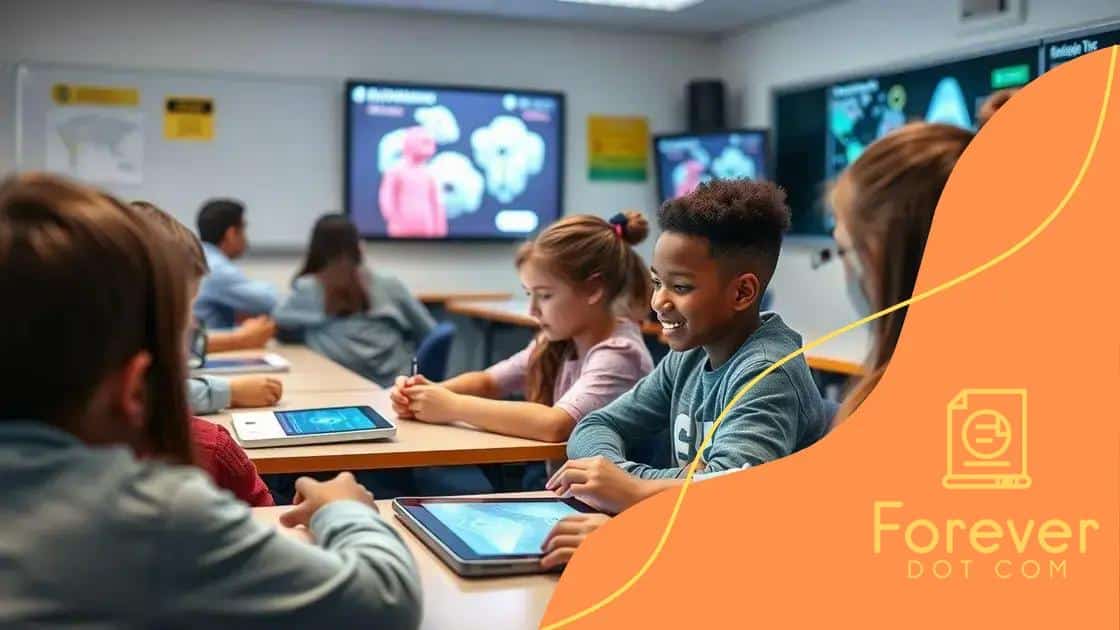AI-powered learning tools for personalized education

AI-powered learning tools provide personalized educational experiences by adapting content and feedback to individual student needs, enhancing engagement and learning outcomes through innovative technologies.
AI-powered learning tools for personalized education are changing the game in classrooms today. Imagine a learning environment tailored specifically to each student’s needs—how could that transform education as we know it?
What are AI-powered learning tools?
AI-powered learning tools are innovative technologies that leverage artificial intelligence to enhance education. These tools adapt to the learning styles and needs of individual students, thereby providing customized educational experiences. Imagine how students can learn at their own pace, benefiting from personalized feedback and resource recommendations.
Types of AI-powered learning tools
There are various types of AI-powered learning tools available, each designed to support different aspects of education. Here are a few key categories:
- Adaptive Learning Systems: These platforms adjust the content and learning paths based on student performance.
- Intelligent Tutoring Systems: These programs provide personalized tutoring and feedback, mimicking one-on-one instruction.
- Learning Analytics: Tools in this category analyze learner data to provide insights and improve educational outcomes.
- Virtual Learning Environments: These are comprehensive platforms that use AI to create immersive learning experiences.
By utilizing AI, these tools can identify gaps in knowledge and suggest resources tailored to individual progress. For instance, if a student struggles with math, the tool can offer additional exercises and interactive tutorials on those specific topics.
Benefits of AI-powered learning tools
Implementing AI tools in the classroom can lead to several significant advantages. These include:
- Personalized Learning: Each student receives a unique learning experience, making education more effective.
- Immediate Feedback: Students can receive prompt responses to their work, helping them correct mistakes swiftly.
- Increased Engagement: Interactive elements keep students motivated and involved in their learning.
The impact of AI-powered learning tools extends beyond just individual achievement. They can also help teachers track progress and adjust their teaching methods based on students’ needs.
Furthermore, as technology evolves, the capabilities of these tools will only expand. Future innovations may bring about even more sophisticated analytical tools that can improve learning outcomes across diverse subjects.
Benefits of personalized education through AI
Personalized education through AI is transforming how students interact with learning. This approach tailors educational experiences to individual needs, enhancing engagement and understanding.
Enhanced Learning Outcomes
One of the most significant benefits of personalized education is improved learning results. Students can work at their own pace, allowing them to master concepts before moving on. This method also leads to better retention of information.
- Faster Skill Acquisition: Students can quickly grasp challenging topics with resources suited to their learning styles.
- Continual Performance Tracking: AI tools provide real-time feedback, helping students understand their progress.
- Individualized Curriculum: Lesson plans can be adjusted to focus on areas where a student needs more help.
Personalized education helps keep students motivated. When learners see their progress, they are encouraged to strive for more. The use of AI in education results in a more engaged classroom atmosphere. Teachers can identify when a student struggles, allowing for timely intervention.
Increased Accessibility
Another notable advantage is the increased accessibility of education. AI-powered learning tools support diverse learners, including those with disabilities or unique challenges. For example, text-to-speech features can assist students with reading difficulties.
- Flexible Learning Environments: Learning can happen anytime and anywhere, providing opportunities for non-traditional students.
- Culturally Relevant Resources: AI can suggest materials that resonate with a student’s background and interests.
- Support for Different Learning Styles: Visual, auditory, and kinesthetic learners can benefit from tailored content delivery.
The result is a more inclusive education system that addresses the needs of every learner, ensuring that no one is left behind. As technology continues to advance, the possibilities for personalized education will further expand, leading to even greater opportunities for students everywhere.
How AI enhances student engagement

AI plays a crucial role in enhancing student engagement by creating more interactive and tailored educational experiences. By incorporating artificial intelligence into learning environments, students can feel more connected and motivated to participate in their education.
Interactive Learning Experiences
One way AI enhances engagement is through interactive tools that make learning more enjoyable. Students can explore content through games, simulations, and virtual reality experiences.
- Gamification: Adding game-like elements to learning makes lessons more fun and competitive.
- Real-Time Feedback: Immediate responses to questions help students understand concepts better, maintaining their interest.
- Customizable Learning Paths: Students can choose their journey through a subject, making learning feel more personal and relevant.
These features boost participation as students are more likely to engage with content that feels dynamic and interactive.
Intelligent Tutoring Systems
Moreover, intelligent tutoring systems provide personalized assistance tailored to each student’s level of understanding. This tailored approach means that students receive help exactly when and where they need it. As a result, they feel supported rather than lost or overwhelmed.
- One-on-One Support: AI tutors can address a student’s specific queries anytime, offering help outside traditional classroom hours.
- Adaptive Challenges: The difficulty of tasks adjusts automatically, keeping students just challenged enough to maintain their interest.
- Progress Tracking: Students can visually see their growth over time, which reinforces their commitment to learning.
Implementing these systems not only helps students grasp complex topics but also builds their confidence in tackling new challenges. By providing a supportive learning landscape, AI ensures that students remain actively engaged and invested in their education.
As AI continues to evolve, so will the opportunities for enhancing student engagement. The future holds exciting possibilities, where learning becomes even more integrated with technology and students’ needs are met more effectively. Schools will increasingly recognize the valuable role that AI can play in driving student interest and achievement.
Challenges of implementing AI in education
Implementing AI in education comes with its own set of challenges. While the benefits are significant, schools and educators face hurdles that must be addressed to fully leverage the potential of technology in the classroom.
Integrating Technology into the Curriculum
One major challenge is effectively integrating AI technologies into existing curricula. Educators must find ways to blend traditional teaching methods with new tools without overwhelming students.
- Training Educators: Teachers need adequate training to understand and use AI tools effectively.
- Content Alignment: Ensuring AI resources align with curriculum standards can be complicated.
- Student Readiness: Students may have varying levels of comfort with technology, which can affect engagement.
Without proper integration, the intended advantages of AI can be lost, leading to disengagement among both teachers and students.
Data Privacy and Security
Another significant issue is data privacy. Utilizing AI often involves collecting and analyzing student data, raising concerns about how this information is used and protected.
- Protecting Personal Information: Schools must ensure that student data is secure and compliant with regulations.
- Consent and Transparency: Educators need to communicate clearly with parents and students about data usage.
- Potential Bias: AI systems can inadvertently perpetuate biases if not carefully monitored.
Maintaining trust among students and parents is crucial. When concerns about privacy arise, they can hinder the acceptance of AI technologies within educational settings.
In addition to these challenges, funding and resources are essential for implementing AI in education. Schools often face budget constraints that limit access to the latest technology and training. Overcoming these financial barriers is critical to ensuring that all students benefit from the advancements AI offers. As these challenges persist, collaboration among educators, administrators, and tech developers will be key to creating effective solutions.
Future trends in AI-driven learning
The future of AI-driven learning presents exciting possibilities for education. As technology advances, we can expect more innovative tools and methods to enhance student experiences and learning outcomes.
Personalized Learning Experiences
One key trend is the growth of highly personalized learning experiences. With AI, educational platforms will increasingly adapt to individual student needs.
- Customized Content: AI can analyze performance data to provide tailored resources that match each student’s learning style.
- Adaptive Learning: Future systems will adjust the difficulty of lessons in real time, keeping students engaged and challenged.
- Intelligent Recommendation Systems: AI will suggest additional materials that can help students master challenging subjects.
This level of personalization makes learning more effective and enjoyable, ensuring students remain motivated.
Virtual and Augmented Reality Integration
Another trend is the integration of virtual reality (VR) and augmented reality (AR) into education. These technologies can provide immersive learning experiences that traditional methods cannot.
- Interactive Environments: VR can transport students to historical events or scientific environments, providing hands-on learning.
- Enhanced Engagement: AR can overlay digital information onto the real world, making lessons more engaging and informative.
- Collaboration Opportunities: Students can work together in virtual settings, fostering teamwork and communication skills.
As these technologies become more accessible, they will transform how students interact with educational content.
Moreover, the increasing use of data analytics in education will play a critical role. Schools will harness data not only to track learning progress but also to identify trends and improve teaching strategies. By analyzing how students learn, educators can refine their approaches and create more effective learning environments.
In summary, the field of AI-driven learning is poised to grow significantly. As new technologies emerge, they will shape education, making it more tailored, interactive, and effective for all learners.
In conclusion, the future of AI-driven learning is bright and full of potential. As we embrace advanced technologies, we can create tailor-made educational experiences that truly meet the needs of all students. Personalized learning, augmented reality, and real-time data analytics will play crucial roles in shaping the way students engage with content. By overcoming challenges related to technology integration and data privacy, we can unlock the full benefits of AI in education. This transformation promises to make learning more interactive, effective, and enjoyable for everyone involved.
FAQ – Frequently Asked Questions about AI in Education
What is AI in education?
AI in education refers to the use of artificial intelligence technologies to enhance learning, personalize experiences, and support teaching methods.
How does personalized learning work with AI?
Personalized learning with AI tailors educational content to each student’s strengths and weaknesses, allowing them to learn at their own pace.
What are some challenges of implementing AI in schools?
Challenges include data privacy concerns, the need for teacher training, and integrating new technologies into existing curricula.
What are future trends in AI-driven learning?
Future trends include personalized learning experiences, the use of virtual reality, and advanced data analytics to track student performance.






